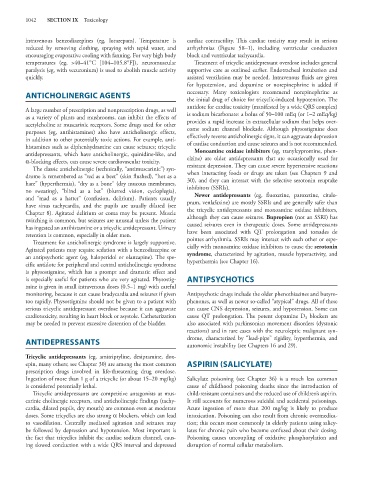Page 1056 - Basic _ Clinical Pharmacology ( PDFDrive )
P. 1056
1042 SECTION IX Toxicology
intravenous benzodiazepines (eg, lorazepam). Temperature is cardiac contractility. This cardiac toxicity may result in serious
reduced by removing clothing, spraying with tepid water, and arrhythmias (Figure 58–1), including ventricular conduction
encouraging evaporative cooling with fanning. For very high body block and ventricular tachycardia.
temperatures (eg, >40–41°C [104–105.8°F]), neuromuscular Treatment of tricyclic antidepressant overdose includes general
paralysis (eg, with vecuronium) is used to abolish muscle activity supportive care as outlined earlier. Endotracheal intubation and
quickly. assisted ventilation may be needed. Intravenous fluids are given
for hypotension, and dopamine or norepinephrine is added if
ANTICHOLINERGIC AGENTS necessary. Many toxicologists recommend norepinephrine as
the initial drug of choice for tricyclic-induced hypotension. The
antidote for cardiac toxicity (manifested by a wide QRS complex)
A large number of prescription and nonprescription drugs, as well is sodium bicarbonate: a bolus of 50–100 mEq (or 1–2 mEq/kg)
as a variety of plants and mushrooms, can inhibit the effects of provides a rapid increase in extracellular sodium that helps over-
acetylcholine at muscarinic receptors. Some drugs used for other come sodium channel blockade. Although physostigmine does
purposes (eg, antihistamines) also have anticholinergic effects, effectively reverse anticholinergic signs, it can aggravate depression
in addition to other potentially toxic actions. For example, anti- of cardiac conduction and cause seizures and is not recommended.
histamines such as diphenhydramine can cause seizures; tricyclic Monoamine oxidase inhibitors (eg, tranylcypromine, phen-
antidepressants, which have anticholinergic, quinidine-like, and elzine) are older antidepressants that are occasionally used for
α-blocking effects, can cause severe cardiovascular toxicity. resistant depression. They can cause severe hypertensive reactions
The classic anticholinergic (technically, “antimuscarinic”) syn-
drome is remembered as “red as a beet” (skin flushed), “hot as a when interacting foods or drugs are taken (see Chapters 9 and
30), and they can interact with the selective serotonin reuptake
hare” (hyperthermia), “dry as a bone” (dry mucous membranes, inhibitors (SSRIs).
no sweating), “blind as a bat” (blurred vision, cycloplegia), Newer antidepressants (eg, fluoxetine, paroxetine, citalo-
and “mad as a hatter” (confusion, delirium). Patients usually pram, venlafaxine) are mostly SSRIs and are generally safer than
have sinus tachycardia, and the pupils are usually dilated (see the tricyclic antidepressants and monoamine oxidase inhibitors,
Chapter 8). Agitated delirium or coma may be present. Muscle although they can cause seizures. Bupropion (not an SSRI) has
twitching is common, but seizures are unusual unless the patient caused seizures even in therapeutic doses. Some antidepressants
has ingested an antihistamine or a tricyclic antidepressant. Urinary have been associated with QT prolongation and torsades de
retention is common, especially in older men. pointes arrhythmia. SSRIs may interact with each other or espe-
Treatment for anticholinergic syndrome is largely supportive.
Agitated patients may require sedation with a benzodiazepine or cially with monoamine oxidase inhibitors to cause the serotonin
syndrome, characterized by agitation, muscle hyperactivity, and
an antipsychotic agent (eg, haloperidol or olanzapine). The spe- hyperthermia (see Chapter 16).
cific antidote for peripheral and central anticholinergic syndrome
is physostigmine, which has a prompt and dramatic effect and
is especially useful for patients who are very agitated. Physostig- ANTIPSYCHOTICS
mine is given in small intravenous doses (0.5–1 mg) with careful
monitoring, because it can cause bradycardia and seizures if given Antipsychotic drugs include the older phenothiazines and butyro-
too rapidly. Physostigmine should not be given to a patient with phenones, as well as newer so-called “atypical” drugs. All of these
serious tricyclic antidepressant overdose because it can aggravate can cause CNS depression, seizures, and hypotension. Some can
cardiotoxicity, resulting in heart block or asystole. Catheterization cause QT prolongation. The potent dopamine D blockers are
2
may be needed to prevent excessive distention of the bladder. also associated with parkinsonian movement disorders (dystonic
reactions) and in rare cases with the neuroleptic malignant syn-
ANTIDEPRESSANTS drome, characterized by “lead-pipe” rigidity, hyperthermia, and
autonomic instability (see Chapters 16 and 29).
Tricyclic antidepressants (eg, amitriptyline, desipramine, dox-
epin, many others; see Chapter 30) are among the most common ASPIRIN (SALICYLATE)
prescription drugs involved in life-threatening drug overdose.
Ingestion of more than 1 g of a tricyclic (or about 15–20 mg/kg) Salicylate poisoning (see Chapter 36) is a much less common
is considered potentially lethal. cause of childhood poisoning deaths since the introduction of
Tricyclic antidepressants are competitive antagonists at mus- child-resistant containers and the reduced use of children’s aspirin.
carinic cholinergic receptors, and anticholinergic findings (tachy- It still accounts for numerous suicidal and accidental poisonings.
cardia, dilated pupils, dry mouth) are common even at moderate Acute ingestion of more than 200 mg/kg is likely to produce
doses. Some tricyclics are also strong α blockers, which can lead intoxication. Poisoning can also result from chronic overmedica-
to vasodilation. Centrally mediated agitation and seizures may tion; this occurs most commonly in elderly patients using salicy-
be followed by depression and hypotension. Most important is lates for chronic pain who become confused about their dosing.
the fact that tricyclics inhibit the cardiac sodium channel, caus- Poisoning causes uncoupling of oxidative phosphorylation and
ing slowed conduction with a wide QRS interval and depressed disruption of normal cellular metabolism.

